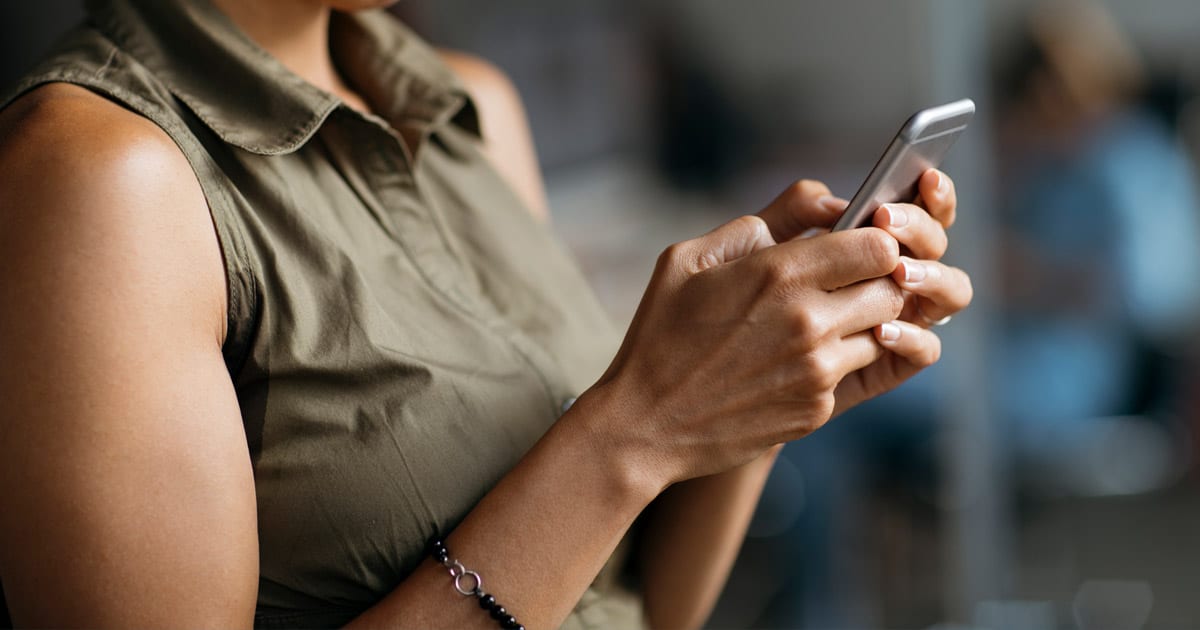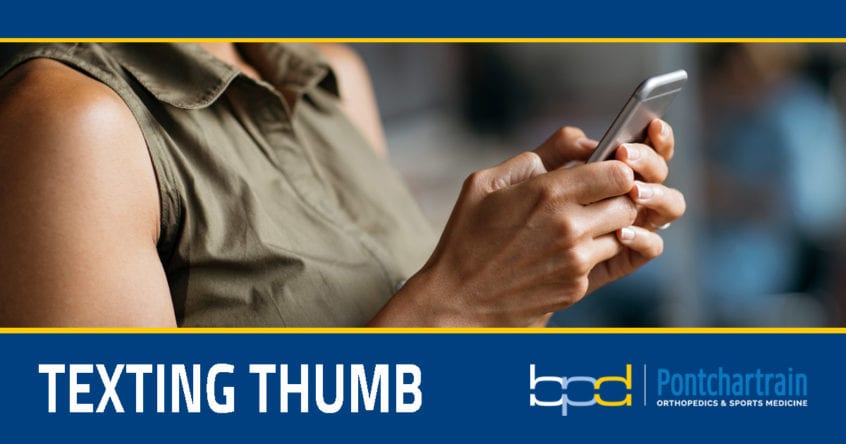
If you’re like most people, you’re on the phone a lot: texting, checking email, looking at social media, playing games, taking pictures. Recent studies show that the more people use their cellphones, the more likely they are to suffer from a condition called “Texting Thumb.”
In today’s post, hand and wrist specialist Brandon P. Donnelly, MD will explain texter’s thumb, also known as De Quervain’s Tendinitis or tenosynovitis.
Ouch! What is texting thumb?
Texting thumb is only the latest name for the painful thumb condition. The repetitive motion injury was first identified way before cell phones by Swiss surgeon Fritz de Quervain in 1895.
Texting thumb develops when the tendons in your wrist and lower thumb become inflamed, swell, and tighten. Swollen tendons that run through the narrow tunnel in your wrist (also known as your carpal tunnel), cause you to feel pain in your thumb. It’s easy to confuse De Quervain’s and carpal tunnel syndrome.
Who is most likely affected?
Middle aged women are prime candidates for De Quervain’s. Women are affected 8 to 10 times more than men with this condition. In the past, texting thumb was associated with repetitive motion injuries like fly fishing, playing piano, or picking up children frequently. Today, however, it has been diagnosed as a result of excessive texting and gaming. Not surprisingly, gamer’s rapid and repetitive thumb movements can cause De Quervain’s.
Symptoms of De Quervain’s
Here are some of the most common symptoms of De Quervain's:
Thumb Pain
The pain usually starts outside the thumb or in the thumb joint. It’s worse when you move your thumb around. You might notice the pain more when you’re texting or typing on your computer. In the beginning, it could simply feel like an ache—as if you’ve overused it (and indeed, you likely have).
Swelling
In addition to your thumb hurting, it may become swollen. Your wrist could also become swollen. The swelling is your body’s attempt to fight the inflammation happening inside your hand and thumb.
Restricted Movement
When you try to grasp or pinch an object, you’ll have difficulty moving your thumb. Range of motion may be limited due to inflammation.
Sticking
Your thumb may feel stuck in place, particularly when you try to move it. It will have a stop and go or catching feeling and will not move smoothly.
"The Finkelstein test can help determine if you have texter’s thumb."Brandon P. Donnelly, MD
How to diagnose De Quervain’s
An evaluation by a specialist is the best way to determine the cause of your thumb pain. Dr. Donnelly listens to the patient’s symptoms, daily activities and performs a physical exam for pain on the thumb side of the wrist.
There is also a test called the Finkelstein test can help determine if you have texter’s thumb. Dr. Donnelly will have you place your thumb against the palm of your hand and close your fingers over the thumb. Then you will tilt your hand toward your little finger. If you have pain when you do this, you may have texter’s thumb. Following an exam, additional imaging may be ordered to confirm the diagnosis.
Treatment options
Here are some of the most common treatment options for De Quervain's:
Text Less!
One of the suggested treatments is to avoid activities that make you have symptoms. This may mean, stop texting. Patients can adapt their phone usage, specifically, voice recording texts or calling instead of texting.
Pain Medications
Minimizing inflammation is important when treating De Quervain's syndrome. Pain and anti-inflammatory medications like NSAIDs may provide relief from pain and reduce swelling.
Splinting
Dr. Donnelly may recommend that you wear a brace or splint. Braces wrap around your hand and wrist and keep your thumb stable as you use it. They also help rest your tendons.
Injections
DeQuervain’s can be effectively treated with corticosteroid injections administered into the steroid sheath to reduce inflammation and provide pain relief. Therapeutic Injection of the Wrist and Hand...
Physical Therapy
If pain medications or a splint don’t relieve pain, a thumb workout in physical therapy might. Strengthening the muscles in the thumb and wrist helps release the tension in your tendons. POSM Orthopedics...
Surgery
Surgery for DeQuervain’s is typically an outpatient procedure. Dr. Donnelly releases the tendon sheath by making a small incision. By doing this, the tendon is given more room and can move more smoothly.
Get a diagnosis if you suspect De Quervain's
Phones and texting aren’t going away any time soon, but that doesn’t mean you have to live with texter’s thumb. Left untreated, the symptoms of texter’s thumb may become more severe, often requiring surgery. There are several options to eliminate the pain in your thumb. Contact us today for an evaluation. Dr. Donnelly can determine if you have texter’s thumb and recommend the most effective treatment for you.
About Dr. Brandon P. Donnelly, MD
 Dr. Brandon P. Donnelly is a board certified hand surgeon with Pontchartrain Orthopedics & Sports Medicine. Dr. Donnelly completed his hand and microsurgery fellowship at the prestigious Philadelphia Hand to Shoulder Center. Dr. Donnelly treats all ages of patients in the greater New Orleans area for hand, wrist, and elbow conditions.
Dr. Brandon P. Donnelly is a board certified hand surgeon with Pontchartrain Orthopedics & Sports Medicine. Dr. Donnelly completed his hand and microsurgery fellowship at the prestigious Philadelphia Hand to Shoulder Center. Dr. Donnelly treats all ages of patients in the greater New Orleans area for hand, wrist, and elbow conditions.
This site is not intended to and does not provide medical advice, professional diagnosis, opinion, treatment or services to you or to any other individual. Through this website and links to other websites, Brandon P. Donnelly, MD provides general information for educational purposes only. The content provided in this website and links, is not a substitute for medical care or treatment. You should not use this information in place of a consultation or the advice of your healthcare provider. Brandon P. Donnelly, MD is not liable or responsible for any advice, course of treatment, diagnosis or any other information, services or product you obtain through this site.

